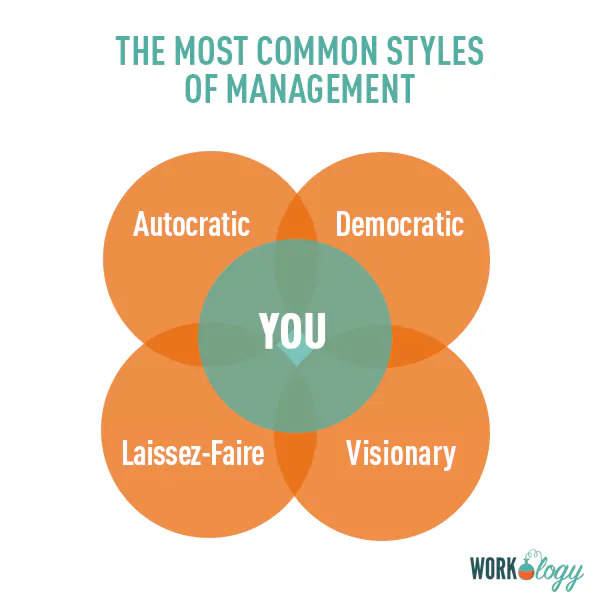There are so many different styles of management that a simple list would be very long, so we’re going to touch on the four most common types of management styles that you’ll see in the workplace today. In order to be an effective manager, you have to take into account that things like company size, industry, country, region, culture, and other internal and external factors mean that you may have to shift how you operate as a manager. For that reason, having a basic understanding of the different management styles can help you adapt to your specific situation.
What Determines How Managers Manage?
One test of a managers’ skills is the ability to adjust their management style in line with internal and external factors – especially if you’re a new manager. Some of these internal factors that new managers have to deal with are staff skills, overall culture, employee engagement, and company policies. The external factors that impact management style include competitors, consumers, suppliers and employment laws in your country or state.
It’s also helpful to think of these as leadership styles, as managers are typically leaders within their company. New managers often need time and training to develop their own leadership methods on their own teams, but learning about the most common types of management styles can help managers do just that.
The Most Common Styles of Management
AUTOCRATIC MANAGEMENT
Autocratic leadership is a management style wherein one person controls all the decisions and takes very little input from other group members. There are subtypes of the autocratic style of management:
Authoritative management style: Managers formulate everything and employees have to follow through or risk punishment. While this style increases decision-making due to defined roles and expectations, it can lead to a high turnover rate and an “us versus them” attitude between employees and management. This style can be effective when an organizational crisis requires fast decision-making to salvage a situation.
Persuasive management style: It is similar to authoritarian leadership in that the manager calls the shots at the end of the day. The only difference is that the manager uses persuasion to make employees agree with the manager’s unilateral decisions. While employees may feel frustrated as they can’t give feedback, the upside to persuasive management makes employees feel included in the decision-making process. This style is effective when managing people who are unfamiliar with the industry or role.
Paternalistic management style: In this approach, the manager treats the employees as family members by acting with their best interests at heart. Although there is no room for collaboration in decision-making, managers will explain their decision to validate them. The downside of this style is that it leads to a lack of creativity and innovation as employees are entirely dependent on their leader.
DEMOCRATIC MANAGEMENT
Managers who practice a democratic management style allow their employees to participate in significant decisions by allowing room for their contributions and ideas. There are subtypes of the democratic style of management:
Consultative management style: Managers allow team members to share ideas and consider them in final decision-making. The assumption in this style is that the employees are experts, and their thoughts are needed to help the management team make informed decisions. Consultative management is appropriate when teams have a unique set of skills.
Participative management style: This allows managers to seek employees’ ideas, thoughts, and input in the decision-making process by giving them access to company information and secrets with complete transparency. Employees under this management style have a feeling of inclusivity that leads to enhanced motivation and productivity.
Collaborative management style: This style allows management an opportunity to create an open forum for ideas to be discussed widely before executing resolutions based on majority rule. Employees are empowered to take ownership of outcomes, leading to increased engagement, innovation, and creativity.
Transformational management style: This management style focuses on flexibility and growth. Managers focus on supporting their teams, pushing them to learn new skills and pushing them outside of their comfort zones. Teams are consistently motivated to raise the bar for achievements and goals.
Coaching management style: Managers in this style use coaching to bring out the best in their employees. Managers see themselves as coaches and employees are treated as esteemed members of their team. The manager’s role is to guide their team’s professional growth. There is room for managers to promote learning, upskilling and development in this style.
LAISSEZ-FAIRE MANAGEMENT
Management gives employees the freedom to do their work as they deem fit by letting their teams make decisions without approval or supervision. This management style is also known as delegative.
Laissez-faire leadership is characterized by the following:
• Hands-off approach
• Leaders provide all training and support
• Decisions are left to employees
• Comfortable with mistakes
• Accountability falls to the leader
VISIONARY MANAGEMENT STYLE
This management style is defined by persuasion, charisma, and a high emotional IQ. Leaders who practice this management style can articulate a vision for the future, and the path others must take to reach it. The hallmark of a visionary leader is his or her ability to mobilize people towards a goal.
Looking for more resources and support for new managers under three years? Take a look at Workology’s New Manager Training Program at www.workplacemasters.com.










